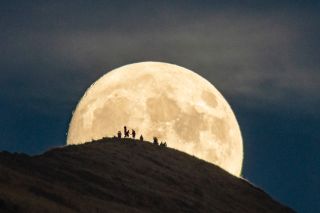See the Harvest Moon of 2018 in These Gorgeous Photos!

The Harvest Moon rose into the evening sky on Monday (Sept. 24), providing some spectacular scenes for skywatchers and photographers around the globe.
A full moon that gets its moniker from its proximity to the autumnal equinox, the Harvest Moon typically arrives in September — though it occasionally falls in October instead. Traditionally, the night of the Harvest Moon was considered an ideal time for farmers to work late into the night, harvesting corn and other crops under the moonlight. [Full Moon Names 2018: From Wolf Moons to Cold Moons]
The Harvest Moon became officially full on Monday (Sept. 24) at 10:52 p.m. EDT (0252 GMT on Sept. 25). As with any other full moon, the Harvest Moon appeared as good as full to the casual observer on the night before it reached its fullest phase, and it will continue to look pretty full the night after. So, if you missed the Harvest Moon last night, it's not too late to see it this evening!

Near San Francisco, California, astrophotographer Kwong Liew captured photos of the Harvest Moon, both when the moon was at its fullest phase and the evening before. In the first photo above, taken from the Mission Peak Regional Preserve just north of San Jose, Liew captured a group of hikers in front of the nearly full — but totally enormous — Harvest Moon.
"To get the moon large in the photo, I use a very long lens to fill up the frame as much as possible and do some cropping," Liew told Space.com in an email. To create this "big moon" illusion, he used an 800-millimeter lens plus a 2.0x converter to achieve a 1,600-mm focal length. "But a lot of times 400 mm to 600 mm will work well also," Liew said. "This depends on how far the foreground subject is from the shooting position."

Another trick for making the moon look huge is to include a subject in the foreground to give it a sense of scale, such as buildings, trees or people, Liew said, adding that it helps to use tools like The Photographer's Ephemeris or PhotoPills to plan the timing and location of a photo shoot.
Liew photographed the Harvest Moon again on Sept. 24, when the moon was at its fullest phase. This time, he watched the moonrise from San Francisco Bay. In another carefully planned view captured near the San Francisco-Oakland Bay Bridge, the moon appears to be skewered on a flagstaff on top of a boat.
Get the Space.com Newsletter
Breaking space news, the latest updates on rocket launches, skywatching events and more!

To keep up with all the full moon dates coming up, check Space.com's Full Moon Calendar and Moon Phases Calendar. And for more handy tips for full-moon photoshoots, check out these Moon Photography Tips from astrophotographers.
Editor's note: If you snap an amazing photo of the Harvest Moon full moon or any other night sky target and you'd like to share it for a possible story or image gallery, please contact managing editor Tariq Malik at spacephotos@space.com.
Email Hanneke Weitering at hweitering@space.com or follow her @hannekescience. Follow us @Spacedotcom, Facebook and Google+. Original article on Space.com.
Join our Space Forums to keep talking space on the latest missions, night sky and more! And if you have a news tip, correction or comment, let us know at: community@space.com.

Hanneke Weitering is a multimedia journalist in the Pacific Northwest reporting on the future of aviation at FutureFlight.aero and Aviation International News and was previously the Editor for Spaceflight and Astronomy news here at Space.com. As an editor with over 10 years of experience in science journalism she has previously written for Scholastic Classroom Magazines, MedPage Today and The Joint Institute for Computational Sciences at Oak Ridge National Laboratory. After studying physics at the University of Tennessee in her hometown of Knoxville, she earned her graduate degree in Science, Health and Environmental Reporting (SHERP) from New York University. Hanneke joined the Space.com team in 2016 as a staff writer and producer, covering topics including spaceflight and astronomy. She currently lives in Seattle, home of the Space Needle, with her cat and two snakes. In her spare time, Hanneke enjoys exploring the Rocky Mountains, basking in nature and looking for dark skies to gaze at the cosmos.
